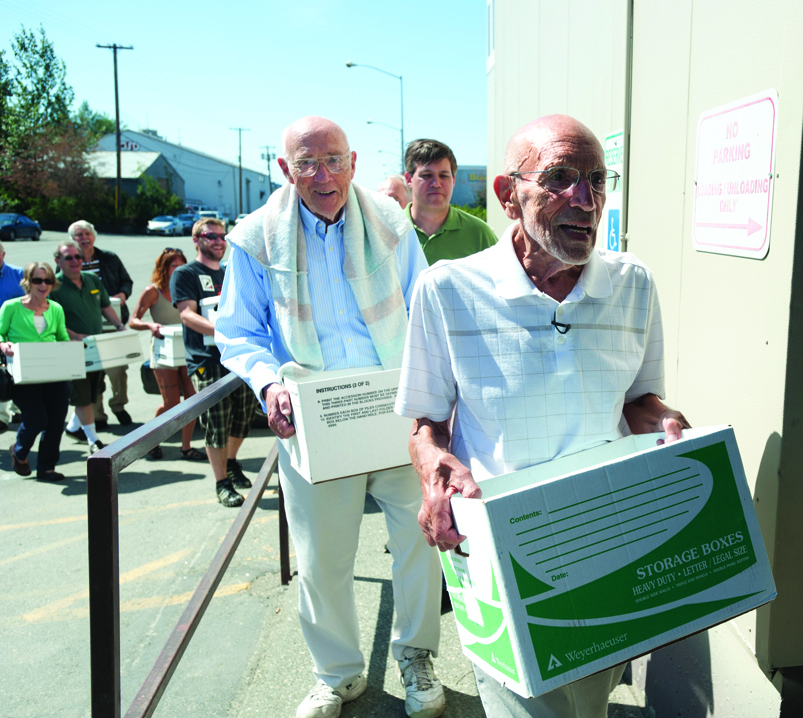A citizen group dissatisfied with the Legislature’s action to reduce oil taxes earlier this year handed petitions with 50,000 signatures to state election officials July 13 calling for a voter referendum to repeal the law.
The signatures are more than enough needed to put a referendum on the August 2014 state primary election ballot, supporters said.
The “Vote Yes — Repeal the Giveaway” group needed 30,169 signatures of registered voters, or 10 percent of the total turnout in the last statewide election, to get the question on the 2014 ballot.
Critics of Senate Bill 21, a bill passed by the Legislature April 14 and signed recently by Gov. Sean Parnell, say the law reduces taxes on industry without adequate guarantees that new investments will be made.
“This bill that they passed is against the interests of Alaska,” Vic Fischer, a former state senator and one of the prime sponsors of the signature-gathering drive, told a group of about 50 tax-cut opponents gathered outside state election offices.
In petition drives, organizers always push to have more than the minimum number of signatures because some are inevitably rejected after they are checked by elections officials. Signers must be registered to vote in Alaska.
Signatures must be checked within 60 days under state law. With 50,000 signatures handed in, Fischer said he is confident there will be enough valid signers to quality for the ballot.
Prior to passage of Senate Bill 21 Alaska had one of the highest tax rates on oil and gas in the world. Under the former law the “total government take” of taxes and state royalty on Alaska production averaged about 74 percent of net profits, consultants to the Legislature said.
As a result, industry investment in new Alaska production has lagged in recent years while investment has boomed in other U.S. producing regions.
The tax change made in the bill that passed lowers the effective rate to between 60 percent and 65 percent, the
consultants said.
There will be negative effects on state revenues, but if the tax change stimulates investment the negative effects could be offset by new production, consultants and state Revenue officials have told legislators.
The fiscal effect is affected substantially by oil prices. If a higher oil price is assumed, the former tax regime would have brought in more money and the fiscal impact of SB 21 would be greater. If a lower price is assumed, the previous tax would bring in less money, and the difference between that and SB 21 would be narrower.
For example, in the state Revenue Department’s analysis the adverse fiscal impact ranges from $490 million to $565 million in fiscal year 2015 (fiscal year 2014 should not be used because it is year of transition between the two tax systems) at the forecast average oil price of $111.67 per barrel.
That increases to a loss of $875 million to $950 million in fiscal year 2018, partly as an effect of a higher oil price assumed by the revenue department, an average of $117.16 per barrel for that year.
However, just what oil prices will be in those years is unknown. The department has a separate set of estimates included with the fiscal analysis that compare the tax effects of the major provisions of SB 21 at a range of oil prices. If the fiscal year 2015 average oil price is $100 per barrel, the adverse revenue effect of SB 21 is estimated at $250 million.
If an average oil price of $120 per barrel is assumed, the revenue loss climbs to $800 million. Similarly, in fiscal year 2018, if a $100 per barrel oil price is used the adverse revenue effect if $375 million. If $120 per barrel is assumed, the adverse effect is $925 million.
The Revenue Department has estimated that $5 billion in new North Slope investment could stimulate enough production to pay for the tax and possibly create new revenues by fiscal year 2018.
Using the same assumptions of oil prices at $100 per barrel and $120 per barrel in fiscal year 2018, the new tax would offset the negative effect of the tax change and bring in $1.1 billion over what the former tax would have earned, according to the analysis.
The $5 billion scenario is hypothetical but industry may actually be moving toward that level of investment, or even more.
In announcements since SB 21 was approved in April, BP and ConocoPhillips have outlined investments in new drilling and projects that could exceed $5 billion, although some of them are still subject to engineering assessments. Some new projects are approved and underway, however.
Meanwhile, the possible voter referendum may have the effect of chilling industry investment, a former Republican state senator and U.S. Interior Department official, Drue Pearce, told legislators from several states and Canadian provinces July 16 at a conference in Anchorage.
“The repeal effort could be a huge disincentive for the governor’s initiative,” Pearce said, referring to Gov. Sean Parnell’s effort to encourage new investment by the oil and gas industry.
Pearce, now a consultant for the law firm of Crowell and Moring, was speaking to the annual meeting of the Pacific Northwest Economic Region, a regional economic association of northwest U.S. states and western Canadian provinces.
Separately, one of the consultants who worked on the tax legislation, Barry Pulliam, with Los Angeles-based Econ One, said the state would suffer serious damage to its reputation if the tax change were repealed.
“It would be a tragedy” if Alaskans voted to repeal the tax change, Pullium said at an oil and gas conference held in Anchorage.
“It would be a long time before Alaska could dig its way out,” from the damage to its reputation, Pulliam said. The conference was by sponsored by K&L Gates, a law firm.
Tim Bradner is a reporter for the Alaska Journal of Commerce. He can be reached at tim.bradner@alaskajournal.com.



